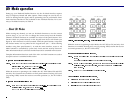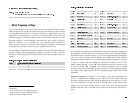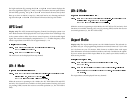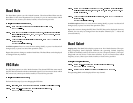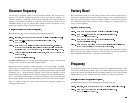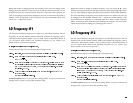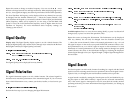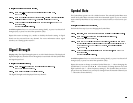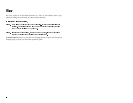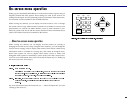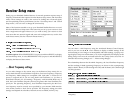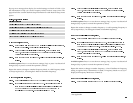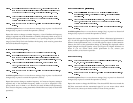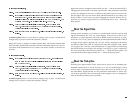
Repeat this action to change to another frequency. You can use the / arrow
buttons to change between low and high resolution. When displaying high resolu-
tion (i.e., least significant digits), the decimal point flashes ON and OFF repeatedly.
The Local Oscillator #2 frequency can be displayed from any channel, but can only
be changed from the Installer Channel (see “…About the current channel”). The
Local Oscillator #2 frequency is associated with the L-Band 2 [Lb2] and Downlink
(dnLn) Frequency Mode, and is required if you are using a dual Ku-Band LNB
system. If used, the Local Oscillator #2 frequency must be higher than the Local
Oscillator #1 frequency. For more information about frequency settings, see
“Setting up the receiver”.
6LJQDO4XDOLW\
Display only: The Signal Quality display option is an Alt-1 Mode function. The
displayed Signal Quality (any number from 0 through 10) is related to the Bit Error
Rate (higher numbers [for Signal Quality] are better).
The Signal Quality can be displayed from any channel.
6LJQDO3RODUL]DWLRQ
The signal Polarization option is an Alt-1 Mode function. The selected signal Po-
larization must match the polarization of the transmitted signal. If you are unsure
about which Polarization to use, contact your dealer/reseller, or local service pro-
vider.
Perform the first step if you are changing the Signal Polarization.
Available options: Press 1 to save the new setting (donE), or press 2 to discard all
changes (rstr), or press 3 to cancel the operation (abrt).
Repeat this action to change the Polarization. The Polarization can be displayed
from any channel, but can only be changed from the Installer Channel (see
“…About the current channel”). When a Horizontal polarization is set, a 19 volt
DC signal is output via the receiver rear panel SATELLITE connector. When a Ver-
tical polarization is set, a 13 volt DC signal is output via this connector. If a fixed
Horizontal or Vertical polarization is set, the setting cannot be changed via uplink
control. Observe the effect of the Polarization change by checking the displayed
relative Signal Strength value (see “Signal Strength“). Higher Signal Strength num-
bers are better.
6LJQDO6HDUFK
The Search option is an Alt-2 mode function. Searching for a signal with the Search
option is used for restoring normal receiver operation if the received signal is inter-
rupted or lost, or is changed by the local broadcast satellite services provider.
A signal search is enabled by setting the Search option to ON, and disabled by set-
ting this option to OFF. When enabled, a signal search is activated automatically
only if the carrier signal is interrupted or lost for more than 20 seconds (normal
operating mode only). For more information about Signal Searches, see “Setting up
the receiver”.



